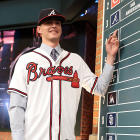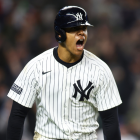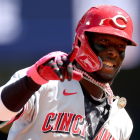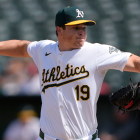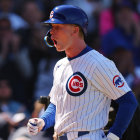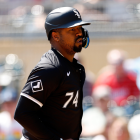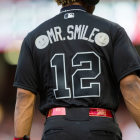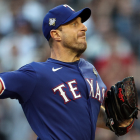Major League Baseball's annual First-Year Player Draft is finally here!
The three-day event started Thursday night with 77 picks covering the first round, supplemental first round, competitive balance round A, second round, and competitive balance round B. Rounds 3-10 will take place Friday, and the draft will conclude with rounds 11-40 on Saturday.
The Phillies opened the draft by selecting high school outfielder Mickey Moniak with the first overall pick. Moniak is the first prep outfielder to go No. 1 overall since the Diamondbacks selected Justin Upton in 2005. Philadelphia held the top selection for the second time in franchise history; they took Pat Burrell first overall in 1998.
We've spent the week previewing and dissecting the draft from myriad angles. We attempted to mock the first round, and got exactly four of 23 first round picks right. Whoops. We also talked to an honest-to-goodness draft expert about what to expect, and we've even reflected on the 2011 class, featuring great young pitcher Jose Fernandez.
The following teams did not have first round picks this year due to free agent compensation:
- Diamondbacks: Forfeited 13th overall pick to sign Zack Greinke.
- Orioles: Forfeited 14th overall pick to sign Yovani Gallardo.
- Nationals: Forfeited 17th overall pick to sign Daniel Murphy.
- Giants: Forfeited 18th overall pick to sign Jeff Samardzija.
- Rangers: Forfeited 19th overall pick to sign Ian Desmond.
- Royals: Forfeited 24th overall pick to sign Ian Kennedy.
- Cubs: Forfeited 27th overall pick to sign John Lackey.
Below is analysis of every first-round and supplemental first-round pick made Thursday night.
| Pick | Team | Pos, Name, School |
| 1 |  Philadelphia Phillies Philadelphia Phillies | OF Mickey Moniak, La Costa Canyon HS (CA) |
| In addition to having an outstanding baseball name, Moniak has been one of the biggest risers in the draft class over the last year. He went from decent prospect to potential No. 1 pick this spring thanks to a true five-tool skill set. Moniak's worst tool is his throwing arm, which is about average. He projects to hit for both power and average long-term thanks to an easy lefty swing and a sound approach. Good speed and instincts make him a no-doubt center fielder as well. Few players in the draft offer similar upside and all-around ability. Moniak is committed to UCLA. | ||
| 2 |  Cincinnati Reds Cincinnati Reds | 3B Nick Senzel, Tennessee |
| After going undrafted out of high school, Senzel is the highest drafted player in Tennessee history. (Todd Helton went eighth overall in 1995.) Senzel is a classic "safe" college bat with great stats -- he hit .325/.456/.595 with eight homers, 25 steals, 40 walks, and 21 strikeouts in 57 games this spring -- and solid tools. He's a patient right-handed hitter who knows how to hammer mistakes, and his dominant showing in the Cape Cod League last summer (led the league with a .976 OPS) showed he can handle high-end pitching with a wood bat. The only real question is Senzel's ultimate position. He's played all over the infield for the Volunteers and has the arm for third, but he's not particularly quick or smooth in the field, leading some to believe he'll wind up at first base down the road. | ||
| 3 |  Atlanta Braves Atlanta Braves | RHP Ian Anderson, Shenendehowa HS (NY) |
| Missing a few weeks with an oblique injury this spring was not enough to keep Anderson out of the first round, though it did limit how often scouts could get their eyes on him. Anderson sits in the low-90s with his heater and folks expect him to eventually settle into the mid-90s once he adds some meat to his 6-foot-3, 170 lb. frame. His breaking ball is inconsistent and it's at its best when he throws it hard like a slider. Anderson has a changeup as well, and he's drawn raves for his aggressiveness and pitching know how. He's committed to Vanderbilt. | ||
| 4 |  Colorado Rockies Colorado Rockies | RHP Riley Pint, St. Thomas Aquinas HS (KS) |
| Pint is the first Kansas high school pitcher to be selected in the first round since the Expos selected Brian Holman with the 16th overall pick in 1983. Pint, an LSU commit, has topped 100 mph several times this spring and will usually live in the 95-98 mph range with his fastball. His hard curveball is a legitimate strikeout pitch. There is some effort in Pint's delivery, which leads to concerns about his long-term command. The pure upside is enormous. | ||
| 5 |  Milwaukee Brewers Milwaukee Brewers | OF Corey Ray, Louisville |
| Ray is the highest drafted player in Louisville history, surpassing teammate Kyle Funkhouser, who did not sign with the Dodgers as the 35th overall pick in 2015. Ray has the draft's best combination of hitting ability and athleticism. He sprays the ball to all fields with a sweet left-handed swing, though he has the most power when he pulls the ball to right. Add in a strong arm, above-average speed, and solid defensive chops in center and right fields, and you have an extremely well-rounded player who can hit almost anywhere in the lineup. | ||
| 6 |  Oakland Athletics Oakland Athletics | LHP A.J. Puk, Florida |
| Most years a 6-foot-7 lefty who regularly flirts with 98-99 mph and has a knockout slider would be an easy call for the No. 1 pick. This year though, there has been some uncertainty surrounding Puk, first and foremost because he's had an up and down college career. He's also missed time with back spasms this spring. At his best, Puk looks like an ace, adding a good changeup to that fastball/slider combination. He fights his command like many pitchers his size, which is why on his worst days he struggles to find the zone and is unable to dominate. Puk has frontline starter stuff. There's no doubt about that. He's in need of some refinement before reaching the show, however. | ||
| 7 |  Miami Marlins Miami Marlins | LHP Braxton Garrett, Florence HS (AL) |
| Owner of one of the best breaking balls in the draft class, Garrett spins a devastating upper-70s curveball that seems allergic to bats. He can throw it for strikes or bury it in the dirt for a swing and miss too. Garrett sits anywhere from 88-95 mph with his fastball. He has a changeup but it is underdeveloped simply because he hasn't needed it a whole lot. Garrett has good size (6-foot-3 and 190 lbs.) and a clean delivery, so he's expected to add some velocity as he matures. As you might expect, he can fall in love with his curveball at times, which won't fly at the next level. He's one of the many impressive arms committed to Vanderbilt. | ||
| 8 |  San Diego Padres San Diego Padres | RHP Cal Quantrill, Stanford |
| Quantrill, the son of former big leaguer Paul Quantrill, has not thrown a single pitch this spring as he rehabs from Tommy John surgery. (He did work out for teams privately before the draft.) Prior to blowing out his elbow last spring Quantrill was the favorite to go first overall this year. When healthy, he offered four pitches that were already close to major league quality: low-90s fastball, curveball, slider, changeup. Quantrill located his heater well to both sides of the plate and he carries himself like a big leaguer on the mound. Teams no longer shy away from Tommy John surgery -- within the last few years Brady Aiken, Jeff Hoffman, and Erick Fedde were all first round picks despite having their elbows rebuilt in the week prior to the draft -- but it is an obvious risk. | ||
| 9 |  Detroit Tigers Detroit Tigers | RHP Matt Manning, Sheldon HS (CA) |
| At 6-foot-6 and 185 lbs., Manning is a classic high school projection pick. He has "now" stuff -- low-to-mid-90s fastball and a hard curveball with feel for a changeup -- and the hope is he will add velocity and power as he fills out that big frame. He's a very good athlete with an advanced feel for pitching. Manning is the son of former NBA player Rich Manning, and he got a late start to his high school season this year because he's a star basketball player as well. He's committed to Loyola Marymount. | ||
| 10 |  Chicago White Sox Chicago White Sox | C Zack Collins, Miami |
| This draft class is light on impact college bats aside from Kyle Lewis and Ray, and Collins just might be the next best hitter after those two. He's a lefty hitter with an ultra-advanced approach, so he'll take his walks if he doesn't get something to hit. Collins has power, especially to the pull side, but he's equally adept at taking a pitch the other way. Behind the plate Collins is a rough defender who doesn't move or throw well. He's either going to have to improve his receiving considerably to stick behind the plate, or move to first base. Either way, he's a bat first player. | ||
| 11 |  Seattle Mariners Seattle Mariners | OF Kyle Lewis, Mercer |
| The first player from Mercer ever selected in the first round, Lewis has the chance to be an even rarer specimen: a middle-of-the-order bat who can play center field. Tall and angular, Lewis combines impressive bat speed and leverage, a combination that could result in 20-plus home runs. The main concerns here are Lewis' swing-and-miss tendencies -- he's overly willing to expand his zone -- and his defensive home, since his present-day arm and range are closer to average than not. The good news is Lewis' bat should still play if he's forced to move to a corner. | ||
| 12 |  Boston Red Sox Boston Red Sox | LHP Jason Groome, Barnegat HS (NJ) |
| A short suspension for violating state transfer rules did not stop Groome from emerging as arguably the top high school pitcher in the draft this spring. He struck out 19 of 21 batters during an April no-hitter -- those stats were wiped from the record books as a result of the transfer violation, though the game still happened -- and showed a lively mid-90s fastball and a tight bat-missing curveball all season. His changeup lags behind his other two pitches. Groome is a big kid (6-foot-6, 220 lbs.) with a clean delivery and good athleticism, so he has true top of the rotation potential. He's committed to Vanderbilt. | ||
| 13 |  Tampa Bay Rays Tampa Bay Rays | 3B Joshua Lowe, Pope HS (GA) |
| Lowe is a legitimate prospect as both a pitcher and position player, though the consensus is he has a brighter future as a hitter. He's a left-handed swinger with a quick bat and some of the biggest raw power in the draft class. Lowe also runs well and has the defensive tools for third base, including a strong arm. There's some thought he could give center field a try. On the mound, Lowe pitches in the low-90s and shows feel for a slider and changeup. He's committed to Florida State, where he would be allowed to both pitch and hit. | ||
| 14 |  Cleveland Indians Cleveland Indians | OF Will Benson, The Westminster Schools (GA) |
| A 6-foot-6, 220-pound outfielder who still hasn't even turned 18, Benson is already a massive presence in the batter's box. He's left-handed and Baseball America has pegged him as having "arguably the best bat speed in the class." They further offer up a Jason Heyward comp, though there are reportedly concerns about Benson's hit tool. As for his power, speed and arm, he grades out very well and is hailed as an excellent all-around athlete. He's committed to Duke, but is seen as signable. | ||
| 15 |  Minnesota Twins Minnesota Twins | OF Alex Kirilloff, Plum HS (PA) |
| Kirilloff is the highest drafted high school player from the Pittsburgh area since the Pirates selected Neil Walker with the 11th pick in 2003. He's a bat first prospect with considerable raw power from the left side of the plate, though he has some swing and miss in his game and needs help refining his approach. Kirilloff is a good athlete who will likely settle into right field long-term, where his arm is well-suited. He's committed to Liberty University. | ||
| 16 |  Los Angeles Angels Los Angeles Angels | C Matt Thaiss, Virginia |
| Thaiss is one of the top collegiate hitters and backstops available, but that doesn't mean he's flawless. Both his arm and receiving skills are considered substandard, and that prompts concerns about his long-term viability behind the plate. Fortunately for Thaiss, his bat makes him an interesting prospect anyway. He's excelled in a tough hitting environment throughout his collegiate career, and while he isn't Kyle Schwarber, he could well hit enough to be valuable at another position, provided his defense doesn't improve with pro instruction. | ||
| 17 |  Houston Astros Houston Astros | RHP Forrest Whitley, Alamo Heights HS (TX) |
| Whitley has everything you want to see in a high school pitching prospect. Size? Check. He's 6-foot-7 and 225 lbs. Big fastball? Yep. He lives in the 93-97 mph range and can cut his fastball too. Out-pitch breaking ball? You bet. Whitley spins a tight low-80s curveball. Third pitch? He has that too in his changeup. Whitley checks just about every box. The only concerns here are body control and command. Like most pitchers his size, Whitley struggles to repeat his delivery and it prevents him from throwing strikes consistently. Everything else is top notch. Whitley is a Florida State recruit. | ||
| 18 |  New York Yankees New York Yankees | OF Blake Rutherford, Chaminade College Prep (CA) |
| Rutherford is no stranger to the prospect scene. He's been on the radar since his freshman year thanks to left-handed hit and power tools that both project to be above-average in the future. Rutherford also has good speed and a strong arm, though he's viewed as a better fit for right field than center long-term. The only real knock on Rutherford is his age; he'll be 19 when he graduates, making him one of the oldest high school players in the 2016 draft class. He's committed to attend UCLA in the fall. | ||
| 19 |  New York Mets New York Mets | RHP Justin Dunn, Boston College |
| Formerly a reliever, Dunn enjoyed a good enough run in the Eagles' rotation to convince many he's a long-term starter. His best assets are his lively fastball and, when he's on, a surprisingly deep arsenal that could feature multiple average or better secondary offerings. Dunn still needs to improve his command and changeup, and it would be nice if one of his breaking balls turned into a legitimate out-pitch. Alas, the other big knock on Dunn is something he can't improve: he's listed at a slight 6-foot-2, 170 pounds. Nonetheless, expect whoever drafts him to give him plenty of opportunities to start. | ||
| 20 |  Los Angeles Dodgers Los Angeles Dodgers | SS Gavin Lux, Indian Trail Academy (WI) |
| Here's a rare sight: a Wisconsin-born player who went in the first round. Lux has bloodlines going in his favor, as his uncle (Augie Schmidt) is a former No. 2 overall pick who currently serves as a collegiate coach. There's more here than connections to a famous name, however. Lux can run and throw and field, and is expected to remain at shortstop for the long haul. If his bat can play average (or near it), then he's a potential starter. | ||
| 21 |  Toronto Blue Jays Toronto Blue Jays | RHP T.J. Zeuch, Pittsburgh |
| The ace of a Pitt team that finished below .500, Zeuch still posted a 6-1 record with a 3.10 ERA this season. He struck out 74 in 69 2/3 innings. Zeuch was taken out of high school, but only in the 31st round, so he decided to head to school and he's drastically improved his stock. The 6-foot-7 righty is obviously imposing on the hill. His fastball sits low-90s, but he's said to have started to hit 97. He also works in a slider, curveball and changeup. He's still projectable, but there's big upside here. | ||
| 22 |  Pittsburgh Pirates Pittsburgh Pirates | 3B Will Craig, Wake Forest |
| The old Moneyball quote "we're not selling jeans here" applies to Craig. He's listed at 6-foot-3 and 235 lbs. and has a thick lower half, which is why he's expected to move across the diamond to first base when it's all said and done. Craig can hit though. He has great bat speed from the right side and he projects to hit 25 or so homers annually at the big league level. Craig knows the strike zone well, so he has the skill set to hit for average, hit for power, and draw walks. His arm is good and his hands are solid in the field, though Craig lacks mobility, which is why he isn't cut out for the hot corner long-term. He's the first Wake Forest player taken in the first round since Allan Dykstra in 2008. | ||
| 23 |  St. Louis Cardinals St. Louis Cardinals | SS Delvin Perez, International Baseball Academy (PR) |
| Perez is the first Puerto Rican player drafted in the true first round since the Astros made Carlos Correa the No. 1 overall selection in the 2012 draft. Perez is a long-term shortstop thanks to quick feet, soft hands, and easy velocity on his throws. His bat lags behind his glove, mostly because he's still learning the strike zone and how to read spin. A right-handed hitter, Perez shows power in batting practice and has high-end bat speed. The tools are special, but he is quite raw. It's worth noting Perez tested positive for a performance-enhancing drug before the draft, causing his stock to fall. | ||
| 24 |  San Diego Padres San Diego Padres | SS Hudson Sanchez, Carroll HS (TX) |
| Sanchez climbed up draft boards with a strong showing on the showcase circuit last summer. He's a right-handed hitter with a very quick bat, and many expect him to add power as he fills out his 6-foot-3, 195 lb. frame. It's uncertain whether Sanchez can remain at shortstop long-term. He has soft hands and a strong arm, but he lacks the mobility for short, and that won't get any better with age. | ||
| 25 |  San Diego Padres San Diego Padres | LHP Eric Lauer, Kent State |
| The Louisville Slugger NCAA Division I Player of the Year, the 6-foot-3 southpaw has achieved pretty much everything that could have been asked of him individually in college, though he was still only a junior this season. In 2016, he was 10-2 with a 0.69 ERA in 104 innings with 125 strikeouts against 28 walks. He'll sit low-90s with his fastball while mixing in a mid-80s slider. Most scouts have Lauer pegged as a mid-to-back rotation arm in the majors. Given his age, the upside here is he might have a very short stint in the minors and offer big-league help in the near-future. | ||
| 26 |  Chicago White Sox Chicago White Sox | RHP Zack Burdi, Louisville |
| The Cardinals' closer heads into Super Regionals with 46 strikeouts against only seven walks in 28 2/3 innings. He's only allowed 15 hits (11 singles, two doubles, two homers) all season. As would be expected in a big-time closer, he's a fireballer, sitting 95-99 and reportedly having hit 101 on the radar gun this year. He'll also use a slider and changeup. With his plus-fastball, a quick rise to becoming a big-league reliever isn't out of the question. | ||
| 27 |  Baltimore Orioles Baltimore Orioles | RHP Cody Sedlock, Illinois |
| A converted reliever, Sedlock is expected to become a professional starter. He projects to have four average or better pitches, led by a heavy sinker. Sedlock has the frame and delivery to handle a starter's workload as well, and might benefit from the belief that he has a fresh arm. Whether you buy that or not, it's not a surprise he didn't go earlier than former teammate Tyler Jay, who went sixth overall in 2015. | ||
| 28 |  Washington Nationals Washington Nationals | 3B Carter Kieboom, Walton High School (GA) |
| The Clemson commit is said to have good power and hit tools to go with a strong arm from third base (he's actually been a shortstop in high school but he profiles as a third baseman in the pros). There are some good bloodlines here, as Kieboom's brother (Spencer) plays in the Nationals system and yet another brother is playing for the University of Georgia. Carter is known as one of the best pure high school hitters in the draft, especially being singled out for his maturity at such a young age. Oh, and this is an awesome baseball name, no? | ||
| 29 |  Washington Nationals Washington Nationals | RHP Dane Dunning, Florida |
| Dunning is a college reliever who is expected to move into the rotation in pro ball. His fastball sits 92-93 mph with a ton of movement, and he backs it up with a good but inconsistent slider. Dunning also throws a promising changeup. He's been squeezed out of Florida's rotation by some higher profile arms, though he definitely has the stuff and size (6-foot-3, 190 lbs.) to start. | ||
| 30 |  Texas Rangers Texas Rangers | LHP Cole Ragans, North Florida Christian HS |
| At 6-foot-3 and 190 lbs., Ragans has the kind of build scouts love. He repeats his delivery and throws three pitches for strikes: low-90s fastball, curveball, and changeup. Ragans locates well and has drawn praise for his pitching aptitude. He's committed to Florida State. | ||
| 31 |  New York Mets New York Mets | LHP Anthony Kay, Connecticut |
| Although Kay is a short southpaw, don't make the mistake of putting him in the bullpen just yet. Rather, he has the chance to become a staple at the back of a big-league rotation thanks to his pitchability and feel for throwing strikes. As is, Kay relies upon his fastball-changeup combination. That can workâlook at Jason Vargas for proofâbut if he can just improve his breaking ball by half a grade, then he'd look like one of the draft's safer bets to take turns in a rotation someday. | ||
| 32 |  Los Angeles Dodgers Los Angeles Dodgers | C Will Smith, Louisville |
| Smith had a lot of helium late in the spring because he's solid on both sides of the ball. He has a very good arm and is a sound receiver, making him an asset behind the plate. Smith has a quick right-handed bat geared more for average than power. Two-way catchers are always hot commodities on draft day, so it's no surprise Smith heard his name called early. | ||
| 33 |  St. Louis Cardinals St. Louis Cardinals | OF Dylan Carlson, Elk Grove HS (CA) |
| Carlson is one of the youngest players in the draft class at 17 and he's the son of a long-time high school coach, so he's grown up around the game. With a quick bat from both side of the plate, Carlson projects to hit for average and could grow into some power. He's not a great athlete and may wind up at first base, but the outfield is also a possibility. Carlson draws rave reviews for his makeup and intangibles. | ||
| 34 |  St. Louis Cardinals St. Louis Cardinals | RHP Dakota Hudson, Mississippi State |
| After pitching sparingly as a freshman and sophomore, Hudson emerged as an SEC ace this year and set a school record with a stretch of 34 2/3 innings without allowing an earned run. At 6-foot-5 and 205 lbs., Hudson throws downhill with a mid-90s fastball and a sharp upper-80s cutter that is his best pitch. The cutter moves so much it often looks like a slider. Hudson also throws a changeup and a curveball, and he did a much better job throwing strikes as a junior than he did earlier in his career. He should climb the minor league ladder quickly. | ||












